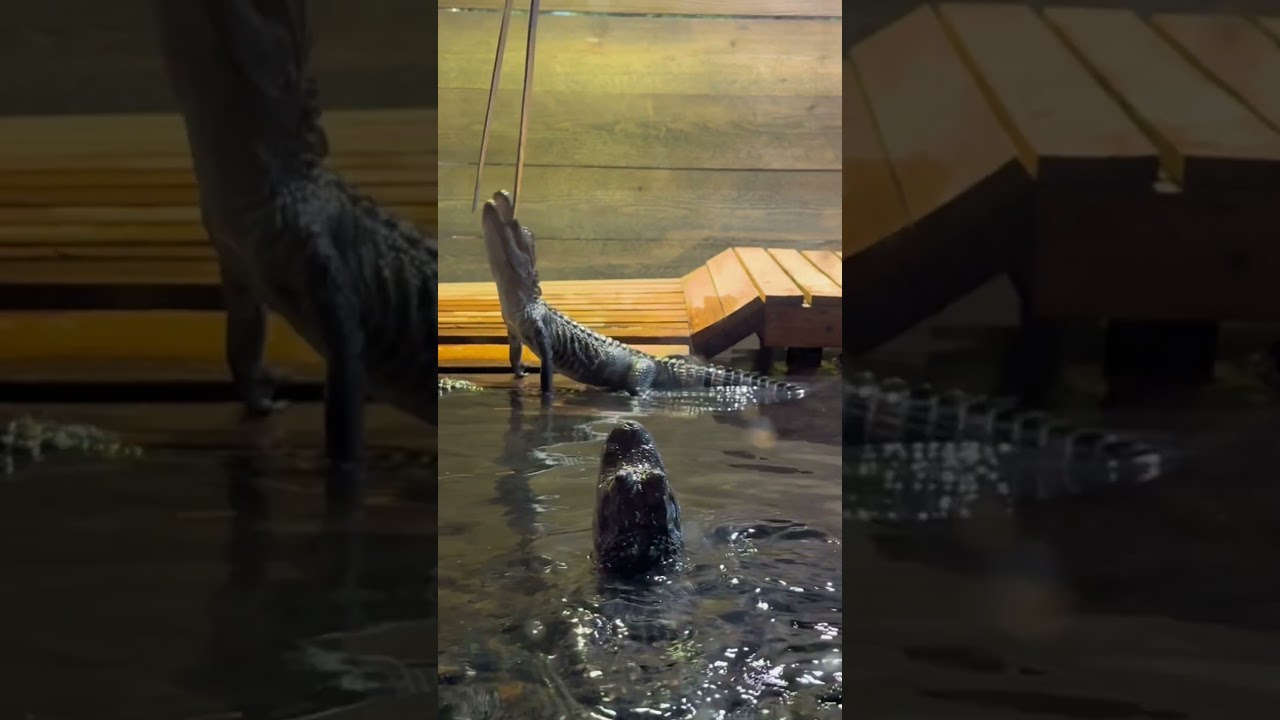– The intricacies of feeding time at the gator nursery and how it contributes to their growth and development.
– Personalized care strategies used by animal care professionals to ensure each baby gator receives optimal nutrition.
– The fascinating social dynamics observed during feeding sessions among young alligators.
Imagine stepping into a world where prehistoric creatures roam, and the splash of water is the soundtrack of a daily ritual – welcome to feeding time for our baby gators. This is not just a moment to satiate hunger; it’s a delicate dance between nurturing caregivers and their reptilian wards, ensuring the health and well-being of these captivating animals.
With each feed, the animal care staff embarks on a meticulous venture. Like parents coaxing toddlers to try new foods, they wield tongs with the utmost precision and attention, offering specially formulated morsels to each young alligator. Here, the names are as varied as their distinct personalities; from the boisterous ‘Snap’ to the contemplative ‘Slide,’ every hatchling is known and cared for as an individual.
Our juvenile alligators, with their armor-like scales and eyes gleaming with ancient wisdom, are more than just inmates of an enclosure; they are a gateway to understanding ecological balance and the importance of conservation. Now, let’s delve into the routine that’s as much a science as it is an art – the feeding time.
### The Symphony Begins
It’s feeding time at the gator nursery, and a calm excitement fills the air. As the feeder approaches, each little alligator’s survival instinct kicks in. There’s a delicate balance here, a trained eye can note – between competition and the patience learned from their kin. Theaff’s role is to attenuate these instincts, nurturing the gators in a controlled environment that prepares them for a life that resembles their natural habitat as closely as possible.
### A Meal Tailored to the Tiniest Predator
Feeding baby gators is more complex than it seems. Their diet is a careful composition, a blend of proteins, vitamins, and minerals, resembling what they would devour in the wild – insects, small fish, and crustaceans. Each bite is a building block for their future, promoting not just growth but the vitality of these endangered species.
The meal is not just thrown en masse – it’s a deliberate process, fully aware that these voracious eaters could easily mistake a sibling’s tail for a tasty treat. Thus, tongs become the extension of human intent, a barrier that safeguards both the provider and the provider.
### The Dance of the Caregiver
Observe the zookeeper’s ballet, a series of intentional steps ensuring that the gator gets its fair share. The staff, acutely aware of the personalities and pecking order, maneuvers expertly to coax the shyer ones out and keep the greedier ones in check. This dance isn’t orchestrated perfection but reactive responses, learning, and adaptation.
### Tuning into Gator Social Etiquette
Even within the boundary of their care, baby gators exhibit complex social behaviors. They learn cues from each other and their human caregivers. Feeding time thus becomes a lesson in manners, where patience often yields the best reward – a hearty meal. Here, socialization is not just incidental; it’s instrumental for their growth into well-adjusted individuals capable of interacting with their species in a respectful, manageable manner.
### The Broader Picture
Beyond the spectacle of snapping jaws and swirling waters, each interaction we witness draws a line to the broader ecological narrative. These baby gators are ambassadors of the wetlands, a reminder of the richness and diversity that graces our planet. The care they receive reflects a larger commitment that encompasses respect, understanding, and the intrinsic value of life in its myriad forms.
Let’s embark on the finer details of this daily ritual and see what makes it uniquely captivating.
—
Feeding time for our baby gators is not merely a routine but a compelling orchestration of nature’s raw nuances molded by human touch. As you approach the enclosure, the first sight to greet you might be a group of hatchlings, each hovering about a foot in length, basking contentedly under the warmth of artificial suns. But do not let their size fool you; these creatures carry the same predatory prowess as their colossal ancestors.
The mood shifts as the staff enters the scene, decked in attire that speaks to both function and a certain reverence for their charges. The gators, attuned to the rhythm of their environment, sense it’s time for sustenance. But it’s not a frantic free-for-all. The scene unfolds with order and finesse, rivaling any fine dining experience.
Each carer comes prepared with tongs and a bucket of specially formulated food – a far cry from the wild’s hapless prey. They initiate the session with a call, a cue for the young reptiles learned through repetition. The response is immediate: a choreographed movement of sleek forms gliding toward the promise of nourishment.
One by one, with names called out, these gators cue up, responding to the familiarity of their assigned human. ‘Snap,’ known for his vivacity, might rush forward, only to be reminded with a gentle tap of the tong that patience is a virtue here. ‘Slide’ approaches strategically, understanding that his turn will come. This notfeeds their bodies and cognitive development, teaching them a rudimentary understanding of social interaction and etiquette.
While we might marvel at this display, it is imperative to note the significance behind such detailed care. These baby gators, currently thriving under the watchful eyes of their caregivers, are key pieces in the conservation puzzle. The populations of their wild counterparts face threats from habitat loss, pollution, and human encroachment. By ensuring the health and well-being of these animals, the staff contributes to breeding programs that bolster their numbers, providing hope for future reintroductions into the wild.
*****
Source Description


